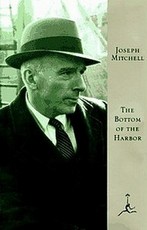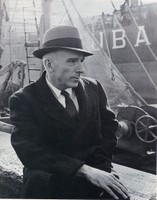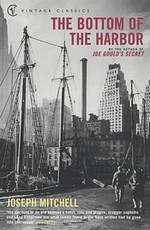Excerpt
from “The Rivermen”:
There are six or seven large factories in Shadyside and six or seven small ones. The Aluminum Company factory is by far the largest, and there is something odd about it. It is made up of a group of connecting buildings arranged in a U, with the prongs of the U pointed toward the river, and inside the U, covering a couple of acres, is an old cemetery. This is the Edgewater Cemetery. 
Most of the old families in Edgewater have plots in it, and some still have room in their plots and continue to bury there. The land on which Edgewater is situated and the land for some distance along the river above and below it was settled in the seventeenth century by Dutch and Huguenot farmers. Their names are on the older gravestones in the cemetery–Bourdetts and Vreelands and Bogerts and Van Zandts and Wandells and Dyckmans and Westervelts and Demarests. According to tradition, the Bourdette family came in the sixteen-thirties–1638 is the date that is usually specified–and was the first one there; the name is now spelled Burdette or Burdett. Some of the families came over from Manhattan and some from down around Hoboken. They grew grain on the slopes, and planted orchards in the shelter of the Palisades. In the spring, during the shad and sturgeon runs, they fished, and took a large part of their catch to the city. The section was hard to get to, except by water, and it was rural and secluded for a long time. In the early eighteen-hundreds, some bluestone quarries were opened, and new people, most of whom were English, began to come in a settle down and intermarry with the old farming and fishing families. They were followed by Germas, and then by Irish straight from Ireland. Building stones and paving blocks and curbing for New York City were cut in the quarries and carried to the city on barges–paving blocks from Edgewater are still in place, under layers of asphalt, on many downtown streets. Some of the new people worked in the quarries, some worked on the barges, some opened blacksmith shops and made and repaired gear for the quarries and the barges, some opened boatyards, and some opened stores. The names of dozens of families who were connected with these enterprises in one way of another are on gravestones in the newer part of the cemetery; Allison, Annett, Carlock, Cox, Egg, Forsyth, Gaul, Goetchius, Hawes, Hewitt, Jenkins, Stevens, Truax, and Winterburn are a few. Some of these families died out, some moved away, and some are still flourishing. The enterprises themselves disappeared during the first two decades of this century; they were succeeded by the Shadyside factories.
The land surrounding the Edgewater Cemetery was once part of a farm owned by the Vreeland family, and the Aluminum Company bought this land from descendants of a Winterburn who married a Vreeland. As a condition of the sale, the company had to agree to provide perpetual access to the cemetery. 
To reach it, funerals go through the truck gate of the factory and across a freight yard and up a cement ramp. It is a lush old cemetery, and peaceful, even though the throb of machinery can be felt in every corner of it. A part-time caretaker does a good deal of gardening in it, and he likes bright colors. For borders, he uses the same gay plants that are used in flower beds at race tracks and seaside hotels–cannas, blue hydrangeas, scarlet sage, and cockscomb. Old men and old women come in the spring, with hoes and rakes, and clean off their family plots and plant old-fashioned flowers on them. Hollyhocks are widespread. Asparagus has been planted here and there, for its feathery, ferny sprays. One woman plants sunflowers. Coarse, knotty, densely tangled rosebushes grow on several plots, hiding graves and gravestones. The roses that they produce are small and fragile and extraordinarily fragrant, and have waxy red hips almost as big as crab apples. Once, walking through the cemetery, I stopped and talked with an old woman who was down on her knees in her family plot, setting out some bulbs at the foot of a grave, and she remarked on the age of the rosebushes. “I believe some of the ones in here now were in here when I was a young woman, and I am past eighty,” she said. “My mother–this is her grave–used to say there were rosebushes just like these all over this section when she was a girl. Along the riverbank, beside the roads, in people’s yards, on fences, in waste places. And she said her mother–that’s her grave over there–told her she had heard from her mother that all of them were descended from one bush that some poor uprooted woman who came to this country back in the Dutch times potted up and brought along with her. There used to be a great many more in the cemetery than there are now–they overran everything–and every time my mother visited the cemetery she would stand and look at them and kind of laugh. She thought they were a nuisance. All the same, for some reason of her own, she admired them, and enjoyed looking at them. ‘I know why they do so well in here,’ she’d say. ‘They’ve got good strong roots that go right down into the graves.'”
Comments–from A Reader’s Delight, by Noel Perrin
 “Mitchell [was] a North Carolinian who became a New Yorker. He went straight from the University of North Carolina to a New York newspaper [The New York Herald Tribune–ed.]. First a reporter, he quickly turned into a feature writer, and then he became an essayist, the best in the city. [He joined the staff of The New Yorker in 1938 and remained with the magazine until his death in 1996, although his last piece for the magazine was published in 1965–ed.]. Some think he was … the best in the country. Others, more temperate, put him in a tie for first with John McPhee.
“Mitchell [was] a North Carolinian who became a New Yorker. He went straight from the University of North Carolina to a New York newspaper [The New York Herald Tribune–ed.]. First a reporter, he quickly turned into a feature writer, and then he became an essayist, the best in the city. [He joined the staff of The New Yorker in 1938 and remained with the magazine until his death in 1996, although his last piece for the magazine was published in 1965–ed.]. Some think he was … the best in the country. Others, more temperate, put him in a tie for first with John McPhee.
Before he ceased to publish, Mitchell brought out five books. At least two of them are masterpieces: McSorley’s Wonderful Saloon and The Bottom of Harbor. I love them both, but I love The Bottom of the Harbor more. I’ve reread it every three or four years for twenty-five years, and my opinion of it is still climbing.
The book contains six long essays, all connected with the waterfront. One–the only one some lesser person might have written–is abouut rats: the three varieties that inhabit New York, spread plagues, come and go on ships. That piece is merely brilliant reporting.
 The other five are a kind of writing for which there is no name. Each tells a story, and is dramatic; each is both wildly funny and so sad you can hardly bear it; each tells its story so much in the words of its characters that it feels like a kind of apotheosis of oral history. Finally, like the Icelandic sagas, each combines a fierce joy in the physicality of living with a stoical awareness that all things physical end in death, usually preceded by years of diminishment. One winds up admiring Mitchell’s characters (all real people), loving them, all but weeping for them, maybe hoping to live as gallantly.
The other five are a kind of writing for which there is no name. Each tells a story, and is dramatic; each is both wildly funny and so sad you can hardly bear it; each tells its story so much in the words of its characters that it feels like a kind of apotheosis of oral history. Finally, like the Icelandic sagas, each combines a fierce joy in the physicality of living with a stoical awareness that all things physical end in death, usually preceded by years of diminishment. One winds up admiring Mitchell’s characters (all real people), loving them, all but weeping for them, maybe hoping to live as gallantly.
… Mitchell, who has a genius for finding real-life metaphors, tells you early on about an old graveyard in the lower part of the town. It’s quite a large one, and it’s still in use. It is entirely surrounded, however, by a modern factory–a huge one, belonging to the Aluminum Company of America. The cemetery forms a two-acre garden in the middle. Funerals go in an out through the factory gate, as do people visiting graves or people who simply want to picnic in the beautiful old graveyard. That was part of the agreement when the company bought part of what was once the Vreeland farm.
Not only that, there are rosebushes in there, descended from a rosebush that came from Holland in the 1630s. Or so, at least, Mitchell hears from an old woman whom he meets (and naturally gets to know) while she is gardening in the graveyard.
Mitchell himself could be called a gardener in a graveyard, if that didn’t make him sound much more lugubrious and much less fun to read than he actually is. … I do know that Mitchell has the gift of making roses bloom in the darkest and most unexpected places.”

I think the best term for what Mitchell wrote is artful non-fiction. His pieces are based on fact, but carefully shaped and selective in detail.
is this truth or fiction?
jeff gaul
albany, ny